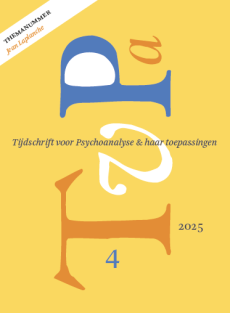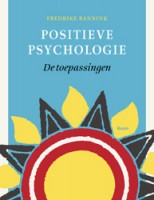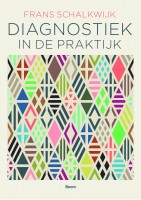Buiten-analytische contacten: meestal onvermijdelijk, vaak onbesproken
Summary
Extra-analytic contacts are mostly unavoidable but often disguised, unexpressed, even inexpressible contacts between analyst and analysand. A thorough analysis of such contact is proposed, as an important part of the transitional area between reality and fantasy. With a defensive analysand, extra-analytic contact can offer an unusually fruitful opportunity to recognize and clarify aspects of the transference situation.
Literatuur
- Bibring, G. (1954), The training analysis and its place in psycho-analytic training. International Journal of Psycho-Analysis, 35, p. 157-162.
- Blecourt, A. de (1991), Voelen, denken en handelen in de psychoanalyse. Van Gorcum, Assen/Maastricht.
- Erikson, E. (1950), Childhood and society. Norton, New York.
- Etchegoyen, H. (1991), The Fundamentals of Psychoanalytic Technique. Karnac Books, London/New York.
- Fairbairn (1958), On the nature and aims of psychoanalytical treatment. International journal of Psycho-Analysis, 39, p. 374-385.
- Fenichel, O. (1941), Problems of Psychoanalytic Technique. Psychoanalytic Quarterly Inc, New York.
- Franklin, G. (1990), The multiple meanings of neutrality. Journal of the American Psychoanalytic Association, 38, p. 195-200.
- Freud, A. (1954), The widening scope of psychoanalysis. Journal of the American Psychoanalytic Association, 2, p. 610-611.
- Freud, S. (1912), Adviezen voor de arts bij de psychoanalytische behandeling. Nederlandse editie: Klinische Beschouwingen 4. Boom, Amsterdam/Meppel.
- Ganzarain, R. (1991), Extra-analytic contacts: fantasy and reality. International Journal of Psycho-Analysis, 72, p. 131-140.
- Godfrind, J. (1993), Les deux courants du transfer. P.U.F., Paris.
- Goldberg, A. (1994), Farewell to the objective analyst. International Journal of Psycho-Analysis, 75, p. 21-30.
- Greenacre, P. (1959), Certain technical problems in the transference relationship. Journal of the American Psychoanalytic Association, 7, p. 484-502.
- Greenson, R. (1967), The Technique and Practice of Psycho-Analysis. Hogarth Press, London.
- Greenson, R. en M. Wexler (1969), The non-transference relationship in the psychoanalytic situation. International Journal of Psycho-Analysis, 50, p. 27-39.
- Inderbitzin, L. en S. Levy (1994), On grist for the mill: external reality as defence. Journal of the American Psychoanalytic Association, 42, p. 763-788.
- Katz, J. (1978), A psychoanalyst’s anonimity – Fiddler behind the couch. Bulletin Menninger Clinic, 42, p. 520-524.
- Lampl-de Groot, J. (1954), Problems of Psychoanalytic Training. In: J. Lampl-de Groot (1985), Man and Mind. Collected Papers. International University Press, New York, p. 164-169.
- Langs, R. (1973/1974), The Technique of Psycho-analytic Psychotherapy, Vol. 1 (1973) en Vol. 2 (1974). Jason Aronson Inc., Northvale/New Jersey/London.
- Langs, R. (1976), The Therapeutic Interaction. Aronson, New York.
- Lax, R.F. (1989), Essential payers on character neurosis and treatment. Universities Press, New York.
- McDougall, J. (1982), Théâtres du Je. Gallimard, Paris.
- Ogden, T. (1994), The analytic third. Working with intersubjective clinical facts. International Journal of Psycho-Analysis, 75, p. 3-19.
- Reich, W. (1933), L’analyse caractérielle. Payot, Paris.
- Stein, M. (1988), Writing about Psychoanalysis: analysts who write, patients who read. Journal of the American Psychoanalytic Association, 36, p. 393-408.
- Stone, L. (1954), The widening scope of indication for psychoanalysis. Journal of the American Psychoanalytic Association, 2, p. 567-594.
- Strean, H. (1981), Extra-analytic contacts: theoretical and clinical considerations. Psychoanalytic Quarterly, 50, p. 238-259.
- Sugarman, A., R.A. Nemiroff en D.P. Greenson (1992), The Technique and Practice of Psycho-Analysis, Vol. 2. International University Press, Madison.
- Swaber, E. (1995), Towards a definition of the term and concept of interaction. International Journal of Psycho-Analysis, 76, p. 557-564.
- Tarnower, W. (1966), Extra-analytic contacts between the psychoanalyst and the patient. Psychoanalytic Quarterly, 35, p. 399-413.
- Verbruggen, G. (1992), Alleen in de groep en niet in groep alleen. Tijdschrift Klinische Psychologie, 22, p. 120-136.
- Weiss, S. (1975), The effect on the transference of special events occuring during psychoanalysis. International Journal of Psycho-Analysis, 56, p. 69-75.
- Wiersema, E. (1994), Verbeelding spreekt. Boom, Meppel/Amsterdam.
- Winnicott, D. (1958), Collected Papers. Tavistock Publications Ltd, London.
 © 2009-2025 Uitgeverij Boom Amsterdam
© 2009-2025 Uitgeverij Boom Amsterdam
ISSN 1382-516x
De artikelen uit de (online)tijdschriften van Uitgeverij Boom zijn auteursrechtelijk beschermd. U kunt er natuurlijk uit citeren (voorzien van een bronvermelding) maar voor reproductie in welke vorm dan ook moet toestemming aan de uitgever worden gevraagd:
Behoudens de in of krachtens de Auteurswet van 1912 gestelde uitzonderingen mag niets uit deze uitgave worden verveelvoudigd, opgeslagen in een geautomatiseerd gegevensbestand, of openbaar gemaakt, in enige vorm of op enige wijze, hetzij elektronisch, mechanisch door fotokopieën, opnamen of enig andere manier, zonder voorafgaande schriftelijke toestemming van de uitgever.
Voor zover het maken van kopieën uit deze uitgave is toegestaan op grond van artikelen 16h t/m 16m Auteurswet 1912 jo. Besluit van 27 november 2002, Stb 575, dient men de daarvoor wettelijk verschuldigde vergoeding te voldoen aan de Stichting Reprorecht te Hoofddorp (postbus 3060, 2130 KB, www.reprorecht.nl) of contact op te nemen met de uitgever voor het treffen van een rechtstreekse regeling in de zin van art. 16l, vijfde lid, Auteurswet 1912.
Voor het overnemen van gedeelte(n) uit deze uitgave in bloemlezingen, readers en andere compilatiewerken (artikel 16, Auteurswet 1912) kan men zich wenden tot de Stichting PRO (Stichting Publicatie- en Reproductierechten, postbus 3060, 2130 KB Hoofddorp, www.cedar.nl/pro).
No part of this book may be reproduced in any way whatsoever without the written permission of the publisher.
Nieuwsbrief Boom Psychologie
Meld u nu aan en ontvang maandelijks de Boom Psychologie nieuwsbrief met aantrekkelijke aanbiedingen en de nieuwe uitgaven.
Aanmelden


